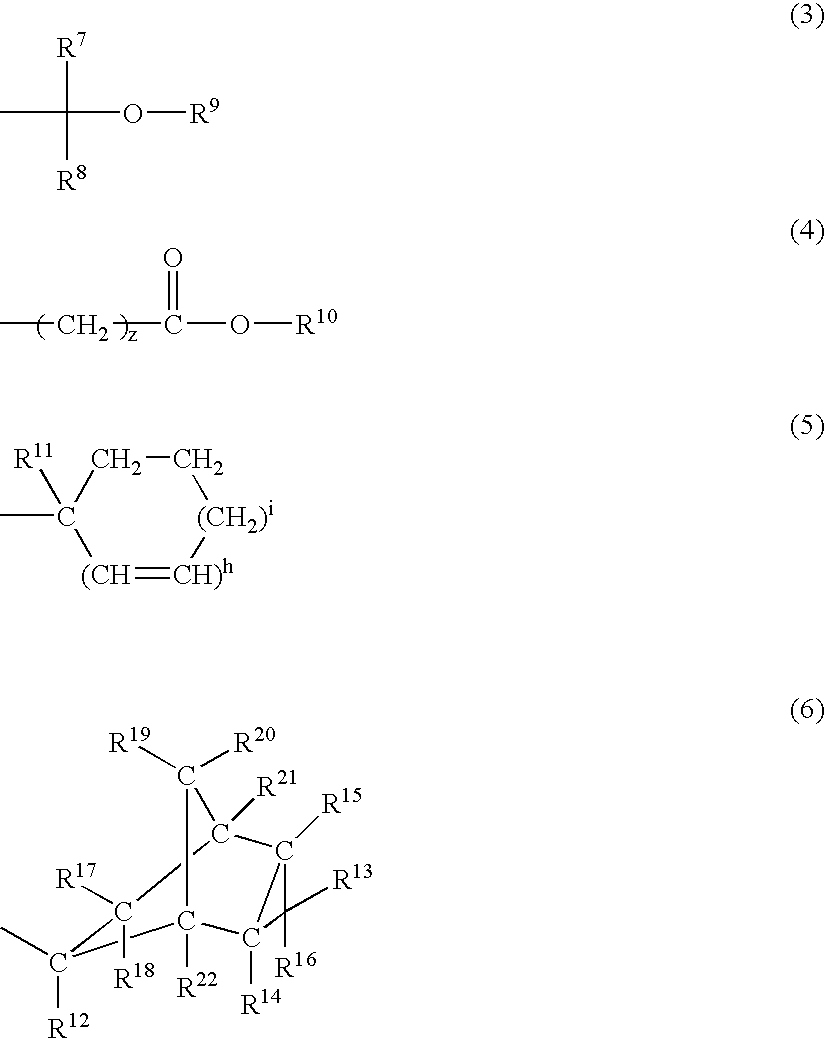Chemically amplified positive resist composition and patterning process
a composition and positive resist technology, applied in the field of chemically amplified positive resist compositions, can solve the problem that the electron beam imagewise writing process takes a longer time than the conventional block exposure process, and achieve the effect of satisfactory pattern profile, high sensitivity and high resolution
- Summary
- Abstract
- Description
- Claims
- Application Information
AI Technical Summary
Benefits of technology
Problems solved by technology
Method used
Image
Examples
synthesis example 1
Synthesis of 2,4,6-triisopropylbenzenesulfonic acid
[0092] To 30.2 g (0.1 mol) of commercially available 2,4,6-triisopropylbenzenesulfonyl chloride were added 30 g of dimethyl sulfoxide and 30 g of water. The mixture was heated and stirred on an oil bath at 80° C. for 3 hours. The dimethyl sulfoxide / water solution was ready for use in the subsequent step of anion exchange reaction.
synthesis example 2
Synthesis of diphenyl-4-methylphenylsulfonium 2,4,6-triisopropylbenzenesulfonate
[0093] In 100 g of dichloromethane were dissolved 20.2 g (0.1 mol) of diphenyl sulfoxide and 32.6 g (0.3 mol) of trimethylsilyl chloride. To the reaction solution which was ice cooled, a tetrahydrofuran solution of 4-methylphenylmagnesium chloride (0.3 mol) which was separately prepared was added dropwise such that the temperature might not exceed 20° C. Then, 10 g of 35 wt % aqueous hydrochloric acid and 200 g of water were added such that the temperature might not exceed 20° C. Finally 100 g of diethyl ether was added.
[0094] The water layer was separated, to which the dimethyl sulfoxide / water solution of 2,4,6-triisopropylbenzenesulfonic acid prepared in Synthesis Example 1 and 300 g of dichloromethane were added, followed by stirring.
[0095] The organic layer was separated, and washed with 200 g of water three times. The organic layer was the concentrated. Diethyl ether was added to the concentrate ...
synthesis example 3
Synthesis of tris(4-methylphenyl)sulfonium 2,4,6-triisopropylbenzenesulfonate
[0100] Using a tetrahydrofuran solution of 4-methylphenylmagnesium chloride, thionyl chloride, and trimethylsilyl chloride, tris(4-methylphenyl)sulfonium chloride was synthesized according to the formulation shown in JP-A 8-311018. This sulfonium chloride was mixed with the sulfonic acid of Synthesis Example 1 whereupon anion exchange reaction was carried out as in Synthesis Example 2, yielding the target compound. The target compound was obtained as white crystals in an amount of 22.4 g and a yield of 38%. It was analyzed by 1H-NMR and IR spectroscopy, with the data shown below.
[0101]1H-NMR (CDCl3, σ ppm) [0102] 1.17-1.19 (12H, d, Ha′), 1.20-1.22 (6H, d, Ha), 2.40 (9H, s, He), 2.77-2.90 (1H, m, Hb), 4.70-4.82 (2H, m, Hc), 7.01 (2H, s, Hd), 7.36-7.39 (6H, d, Hg), 7.66-7.71 (6H, d, Hf)
[0103] IR (cm−1) [0104] 3045, 2960, 2863, 1591, 1490, 1457, 1421, 1403, 1199, 1162, 1083, 1070, 1049, 1012, 809, 674, 588...
PUM
| Property | Measurement | Unit |
|---|---|---|
| Time | aaaaa | aaaaa |
| Force | aaaaa | aaaaa |
| Nanoscale particle size | aaaaa | aaaaa |
Abstract
Description
Claims
Application Information
 Login to View More
Login to View More - R&D
- Intellectual Property
- Life Sciences
- Materials
- Tech Scout
- Unparalleled Data Quality
- Higher Quality Content
- 60% Fewer Hallucinations
Browse by: Latest US Patents, China's latest patents, Technical Efficacy Thesaurus, Application Domain, Technology Topic, Popular Technical Reports.
© 2025 PatSnap. All rights reserved.Legal|Privacy policy|Modern Slavery Act Transparency Statement|Sitemap|About US| Contact US: help@patsnap.com



